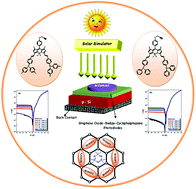Fabrication of hybrid photodiode systems: BODIPY decorated cyclotriphosphazene covalently grafted graphene oxides†
Abstract
Combination of graphene sheets with various organic/inorganic functional groups could enhance the applications of graphene-based hybrid materials. Among them, BODIPY dyes are critically important due to their unique photonic properties and cyclophosphazenes are an excellent scaffold to anchor two or more chromophores. Thus, many attractive photonic characteristics can be shown in graphene/cyclophosphazene–BODIPY hybrid systems. Herein, the construction, synthesis and development of graphene-based hybrids (GO-CP–BODIPY) for enhanced photosensor applications were shown. Moreover, the photo-electrochemical properties of the novel hybrids were studied in particular using a photoconductivity measurement system. The produced photodiodes were quite sensitive to exposure light and exhibited photoconducting behavior under illumination light. The values of ideality factor and barrier height, which are two of the basic electrical parameters of a photodiode, were determined with the help of current–voltage characteristics for different light intensities. In addition to the dark current, it was found that a photocurrent was formed by the effect of illumination. Furthermore, the capacitance versus time measurements performed at different light intensities showed that the device exhibited photocapacitive behavior. It is considered that the produced device in this study could be used in organic-based optoelectronic applications, especially as a photodiode or photosensor.



 Please wait while we load your content...
Please wait while we load your content...